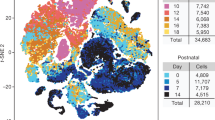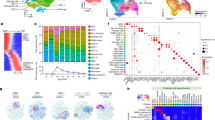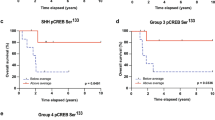Abstract
Overexpression of the polycomb group gene Bmi1 promotes cell proliferation and induces leukaemia through repression of Cdkn2a (also known as ink4a/Arf) tumour suppressors1,2. Conversely, loss of Bmi1 leads to haematological defects and severe progressive neurological abnormalities in which de-repression of the ink4a/Arf locus is critically implicated1,3. Here, we show that Bmi1 is strongly expressed in proliferating cerebellar precursor cells in mice and humans. Using Bmi1-null mice we demonstrate a crucial role for Bmi1 in clonal expansion of granule cell precursors both in vivo and in vitro. Deregulated proliferation of these progenitor cells, by activation of the sonic hedgehog (Shh) pathway, leads to medulloblastoma development4. We also demonstrate linked overexpression of BMI1 and patched (PTCH), suggestive of SHH pathway activation, in a substantial fraction of primary human medulloblastomas. Together with the rapid induction of Bmi1 expression on addition of Shh or on overexpression of the Shh target Gli1 in cerebellar granule cell cultures, these findings implicate BMI1 overexpression as an alternative or additive mechanism in the pathogenesis of medulloblastomas, and highlight a role for Bmi1-containing polycomb complexes in proliferation of cerebellar precursor cells.
This is a preview of subscription content, access via your institution
Access options
Subscribe to this journal
Receive 51 print issues and online access
$199.00 per year
only $3.90 per issue
Buy this article
- Purchase on Springer Link
- Instant access to full article PDF
Prices may be subject to local taxes which are calculated during checkout




Similar content being viewed by others
References
Jacobs, J. J., Kieboom, K., Marino, S., DePinho, R. A. & van Lohuizen, M. The oncogene and Polycomb-group gene bmi-1 regulates cell proliferation and senescence through the ink4a locus. Nature 397, 164–168 (1999)
Jacobs, J. J. et al. Bmi-1 collaborates with c-Myc in tumorigenesis by inhibiting c-Myc-induced apoptosis via INK4a/ARF. Genes Dev. 13, 2678–2690 (1999)
van der Lugt, N. M. et al. Posterior transformation, neurological abnormalities, and severe hematopoietic defects in mice with a targeted deletion of the bmi-1 proto-oncogene. Genes Dev. 8, 757–769 (1994)
Dahmane, N. & Ruiz-i-Altaba, A. Sonic hedgehog regulates the growth and patterning of the cerebellum. Development 126, 3089–3100 (1999)
Kenney, A. M., Cole, M. D. & Rowitch, D. H. Nmyc upregulation by sonic hedgehog signaling promotes proliferation in developing cerebellar granule neuron precursors. Development 130, 15–28 (2003)
Knoepfler, P. S., Cheng, P. F. & Eisenman, R. N. N-myc is essential during neurogenesis for the rapid expansion of progenitor cell populations and the inhibition of neuronal differentiation. Genes Dev. 16, 2699–2712 (2002)
Huard, J. M., Forster, C. C., Carter, M. L., Sicinski, P. & Ross, M. E. Cerebellar histogenesis is disturbed in mice lacking cyclin D2. Development 126, 1927–1935 (1999)
Park, I. K. et al. Bmi-1 is required for maintenance of adult self-renewing haematopoietic stem cells. Nature 423, 302–305 (2003)
Lessard, J. & Sauvageau, G. Bmi-1 determines the proliferative capacity of normal and leukaemic stem cells. Nature 423, 255–260 (2003)
Molofsky, A. V. et al. Bmi1 dependence distinguishes neural stem cell self-renewal from progenitor proliferation. Nature 425, 962–967 (2003)
Wechsler-Reya, R. J. & Scott, M. P. Control of neuronal precursor proliferation in the cerebellum by Sonic Hedgehog. Neuron 22, 103–114 (1999)
Rubin, J. B. & Rowitch, D. H. Medulloblastoma: a problem of developmental biology. Cancer Cell 2, 7–8 (2002)
Zurawel, R. H. et al. Analysis of PTCH/SMO/SHH pathway genes in medulloblastoma. Genes Chromosom. Cancer 27, 44–51 (2000)
Wechsler-Reya, R. & Scott, M. P. The developmental biology of brain tumors. Annu. Rev. Neurosci. 24, 385–428 (2001)
Taylor, M. D. et al. Mutations in SUFU predispose to medulloblastoma. Nature Genet. 31, 306–310 (2002)
Dong, J., Gailani, M. R., Pomeroy, S. L., Reardon, D. & Bale, A. E. Identification of PATCHED mutations in medulloblastomas by direct sequencing. Hum. Mutat. 16, 89–90 (2000)
Pietsch, T. et al. Medulloblastomas of the desmoplastic variant carry mutations of the human homologue of Drosophila patched. Cancer Res. 57, 2085–2088 (1997)
Pomeroy, S. L. et al. Prediction of central nervous system embryonal tumour outcome based on gene expression. Nature 415, 436–442 (2002)
Herms, J. et al. C-MYC expression in medulloblastoma and its prognostic value. Int. J. Cancer 89, 395–402 (2000)
Tomlinson, F. H. et al. Aggressive medulloblastoma with high-level N-myc amplification. Mayo Clin. Proc. 69, 359–365 (1994)
Marino, S., Vooijs, M., van Der Gulden, H., Jonkers, J. & Berns, A. Induction of medulloblastomas in p53-null mutant mice by somatic inactivation of Rb in the external granular layer cells of the cerebellum. Genes Dev. 14, 994–1004 (2000)
Lee, Y. et al. A molecular fingerprint for medulloblastoma. Cancer Res. 63, 5428–5437 (2003)
Smith, K. S. et al. Bmi-1 regulation of INK4A-ARF is a downstream requirement for transformation of hematopoietic progenitors by E2a-Pbx1. Mol. Cell 12, 393–400 (2003)
Ruppert, J. M., Vogelstein, B. & Kinzler, K. W. The zinc finger protein GLI transforms primary cells in cooperation with adenovirus E1A. Mol. Cell. Biol. 11, 1724–1728 (1991)
Miyoshi, H., Blomer, U., Takahashi, M., Gage, F. H. & Verma, I. M. Development of a self-inactivating lentivirus vector. J. Virol. 72, 8150–8157 (1998)
Acknowledgements
We thank P. Kleihues and H. Ohgaki for providing medulloblastoma samples; M. Grotzer for medulloblastoma cell lines; E. R. Fearon for RK3E cells; M. Ruppert for Gli cDNAs; D. Trono for the lentivirus Bmi1 construct; I. Camenisch for technical help; and K. Kieboom for animal care. MATH-1 and mGluR-2 probes were gifts from H. Zoghbi and S. Nakanishi, respectively. We thank A. Lund, M. Hernandez and S. Bruggeman for discussions, and P. U. Heitz for support. This work was supported by grants from the ‘Krebsforschung Schweiz’ to S.M. and from the ‘Novartis Stiftung’ to S.M.; M. L. and E. T. were supported by a Pioneer grant from the Netherlands organization for Scientific Research to M.v.L.
Author information
Authors and Affiliations
Corresponding authors
Ethics declarations
Competing interests
The authors declare that they have no competing financial interests.
Supplementary information
Supplementary Figure 1
Immunohistochemical detection of Bmi1 expression in neural progenitors of the developing EGL and NE at E14.5 in the mouse (middle). No expression in E14.5 Bmi1-/- embryos (left). Note the similar Bmi1 expression in the EGL of a 17.GW human embryo (right). (PDF 146 kb)
Supplementary Figure 2
Lack of Bmi1 overexpression in 7 glioblastomas (number 1 to 7, A=normal adult cerebellum and M=medulloblastoma). (PDF 42 kb)
Supplementary Information
Includes figure legends and supplementary methods (PDF 33 kb)
Rights and permissions
About this article
Cite this article
Leung, C., Lingbeek, M., Shakhova, O. et al. Bmi1 is essential for cerebellar development and is overexpressed in human medulloblastomas. Nature 428, 337–341 (2004). https://doi.org/10.1038/nature02385
Received:
Accepted:
Issue Date:
DOI: https://doi.org/10.1038/nature02385
This article is cited by
-
BMI1 regulates multiple myeloma-associated macrophage’s pro-myeloma functions
Cell Death & Disease (2021)
-
Inositol treatment inhibits medulloblastoma through suppression of epigenetic-driven metabolic adaptation
Nature Communications (2021)
-
MEIS1 promotes expression of stem cell markers in esophageal squamous cell carcinoma
BMC Cancer (2020)
-
Radiotherapy targeting cancer stem cells “awakens” them to induce tumour relapse and metastasis in oral cancer
International Journal of Oral Science (2020)
-
Cancer stem cell self-renewal as a therapeutic target in human oral cancer
Oncogene (2019)
Comments
By submitting a comment you agree to abide by our Terms and Community Guidelines. If you find something abusive or that does not comply with our terms or guidelines please flag it as inappropriate.



